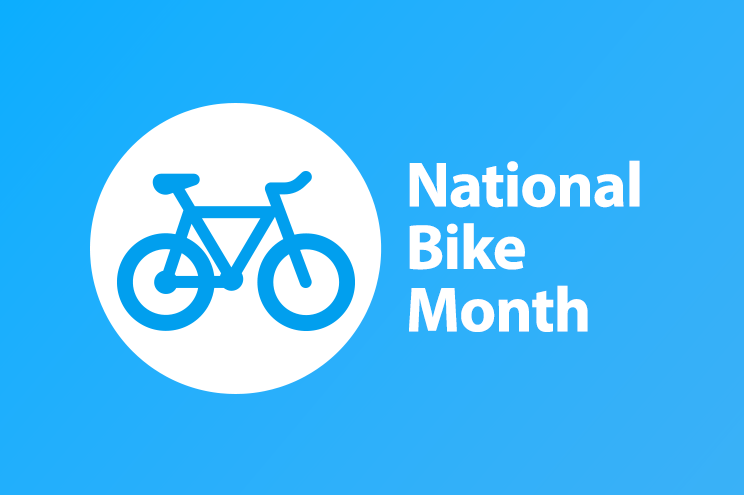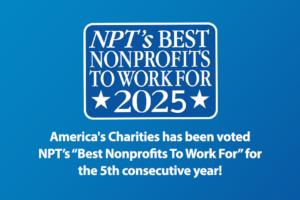America's Charities | April 8, 2024
Bike to Work This Month!
40% of all trips in the U.S. are less than two miles, making bicycling a feasible and fun way to get to work. Established in 1956 by The League of American Bicyclists, Bike-to-Work Day – which is held on the third Friday each May (May 17th in 2024) – was started to promote bicycling as an option for commuting. Since then, the event has expanded to a month-long event with a dedicated celebration week (May 13-19), with communities all across the country celebrating this healthy, sustainable, and economic alternative to other methods of transit.
In addition to celebrating Bike to Work Day (or Bike to Work Week) by doing the obvious – biking to work – here are some ways you can show your support and participate in this event:
- Looking for a bike trail to take? Whether you are biking to work or just want to get out and bike around your community, use Rails-to-Trails Conservancy’s TrailLink to find a trail near you.
- Help fund the maintenance and creation of new trails: Donate to Rails-to-Trails Conservancy (RTC), a nonprofit organization dedicated to creating a nationwide network of trails from former rail lines and connecting corridors to build healthier places for healthier people. (RTC) serves as the national voice for more than 160,000 members and supporters, 31,000 miles of rail-trails and multi-use trails, and more than 8,000 miles of potential trails waiting to be built, with a goal of creating more walkable, bikeable communities in America. Click here to learn more about their organization ways to support their work.
- Support sustainability and world population stabilization: We reached a milestone population of 300 million in 2006 and are hurtling toward a population of over 400 million by 2050. Urbanization can be a boon to population stabilization, but when urbanization is paired with development that isn’t planned with sustainability in mind, sprawl is all too often the result. But population growth in and around cities does not have to create sprawl if cities are planned with sustainability in mind. Dense housing (apartments and condos instead of single family homes), ample affordable public transportation, and jobs near shopping and housing all lessen the effects of population growth on the rate of sprawl in a community. Tysons Corner is currently a traffic-choked business and shopping area 14 miles west of Washington, DC. This “edge city” grew up around the 9th largest indoor mall in the U.S., a pattern recognizable in suburban communities around the country. The commercial district employs 120,000 people—it’s the 12th biggest employment center in the country—but currently houses only 17,000. “Every morning, 110,000 cars arrive, and they all leave at 5,” says Clark Tyler, chairman of Fairfax County’s Tysons Corner Land Use Task Force. But all that is about to change because Tysons is getting a long-overdue makeover. Beginning in 2013, a new Metro line extending from DC to Dulles Airport will stop in four Tysons locations along the way, bringing the subway system to the area for the first time. High-density housing with retail on the first floor is being built within a half-mile of these four Metro stops. New sidewalks and bike and pedestrian lanes will help expand transportation options beyond the single passenger vehicle. Suburban sprawl may have been the predominant trend during the second half of 20th Century America, but high-density, walkable development may be the trend going forward.
Did You Know? One of the most cost-efficient ways you can support these nonprofits is to donate to them through your employer’s workplace giving program (Don’t have a program? Click here to have your employer contact our team.) Click on each charity’s name below to learn more about their work, and for more ways to support them!

Get Resources and Insights Straight To Your Inbox
Explore More Articles
For Fifth Consecutive Year America’s Charities Named ‘Best Nonprofit To Work For’
Washington, D.C. – April 1, 2025 – America’s Charities, the nonprofit that mobilizes the power of giving as a leading provider of volunteering, workplace giving,…
Read ArticleWorkplace Fundraising + Volunteering Summit (April 2nd and 3rd, 2025)
Join us in attending this virtual summit! The America’s Charities team is joining up with other leading voices in the workplace giving space for a…
Read ArticleThe Time to Act is Now
The results of the 2024 National Assessment of Educational Progress (NAEP) are in, and the findings are, in a word, heartbreaking. This assessment serves as…
Read ArticleGet Resources and Insights Straight To Your Inbox
Receive our monthly/bi-monthly newsletter filled with information about causes, nonprofit impact, and topics important for corporate social responsibility and employee engagement professionals, including disaster response, workplace giving, matching gifts, employee assistance funds, volunteering, scholarship award program management, grantmaking, and other philanthropic initiatives.




